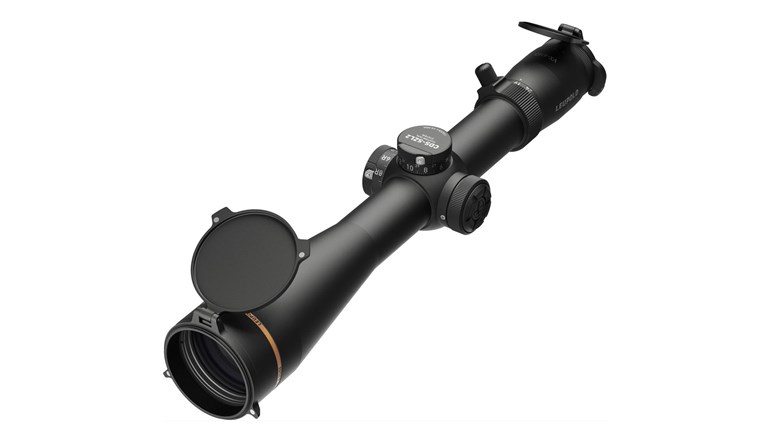

Fathered by John C. Garand's U.S. Rifle, Caliber .30, M1, the M14 retained virtually all of the fine points of its predecessor, while adding a number of improvements. Among these was a shorter, more efficient version of the .30 M2 (.30-06 Sprg.) cartridge, the 7.62 NATO (.308 Win.), a more efficient gas system and a 20-round, detachable-box magazine. The M14 also weighed a pound less than the 9-pound M1 Garand, but it wasn't all good news.
Taking a decade to design and develop through a web of politics, the otherwise excellent M14 came up short in a couple of departments and went way overboard in another. What should have been a priority from the start was a good optical sight base, but instead, the M14 came with a mediocre one, at best. On the opposite end of the spectrum was the inclusion of a well-designed selective-fire capability on a rifle that should never have had one. The value of the rifle's conventional stock at a time when pistol grip stocks were well established remains debatable, as does the adoption of a full-power main-battle cartridge when several excellent intermediate rounds existed. And, there was another fly in the ointment.

This was the experimental Small Caliber High Velocity (SCHV) Pro-gram that caught the eye of Gen. Willard G. Wyman, of Continental Army Command, about the time the M14 was adopted. General Wyman told Eugene Stoner he wanted a lightweight selective-fire rifle shooting a high-velocity .22-caliber bullet. By the time the AR-15 and its 5.56 NATO cartridge were developed, the U.S. military was in Vietnam. The Air Force and then the Army adopted the rifle, mothballed the M14 and sentenced the American infantry to a half-century armed with a semi-effective shoulder weapon.
During and after the Vietnam era, the jury remained hung on the 5.56 NATO cartridge, and hope continues to linger while attempts are made to develop more effective .22-caliber bullets that comply with treaty obligations. However, the distances of engagement dictated by the Global War on Terror quickly made it painfully obvious something more effective was needed to reach much farther. The rifle of choice was something we already had—the M14.
Although the Clinton Adminis-tration had tried to strip the U.S. military of its M14 rifles by giving hundreds of thousands to our friends in other countries, significant numbers remained. Concurrently, a commercial semi-automatic M1A rifle had been very successfully marketed by Springfield Armory of Illinois, and its popularity had generated a number of aftermarket improvements and accessories for it and the M14. When the U.S. Army decided to upgrade and field the M14 in the Middle East, the firearm industry wasted no time.

Improved optical sights, mounts, stocks and a host of other accessories for the M14/M1A platform soon began to appear, such as those from A.R.M.S., Sage International, Smith Enterprise and others. Smith Enterprise has upgraded many M14 rifles for the military using the Leupold Mark 4 3.5-10x30 mm sniper scope and the Sage EBR stock, adopted as the MK14. You can optimize the M14/M1A in a number of ways, and we'll begin with one from Vltor Weapon Systems.
Vltor Weapon Systems
Starting with a new, synthetic, U.S. military M14 stock, Vltor converts it to replace the standard buttstock and use Vltor's own fully adjustable Emod buttstock system that includes a separate pistol grip. Removing the upper sling mount also allows the stock to accommodate Vltor's new combination QD sling and bipod mount. Just as impressive is Vltor's sleek new M14/M1A metal handguard.
The CAS-M1A, the new ventilated handguard, is an improved version of the system Vltor has made commercially for Springfield Armory. Rigidly mounted to the rifle's operating-rod guide, this metal handguard runs from the ferrule all the way back to the receiver where it locks onto the rear of the barrel. On top of the handguard is a mil-spec 1913 rail that runs from the front all the way past the rear of the handguard to lock onto a special base that replaces the rifle's charging handle guide. This system provides a mounting platform identical to that offered by a flattop AR-type rifle, as well as some now offered for bolt-action rifles. Along both sides of the handguard are heavy-duty mounts for Vltor's ancillary rails on which can be mounted lights and laser designators such as those from Laser Devices and Insight. Vltor's Epod two-piece bipod is particularly suitable to mount on the side rails.
A revolution in bipod design, it rigidly mounts to each side rail of the CAS-M1A or any other 3- and 9-o'clock rail system. The Epod's legs will lock either forward or backward when stored and vertically when deployed. When the Epod's legs are deployed, the fulcrums are positioned at about the center of the bore instead of well below the bore line like a conventional bipod. This causes the rifle to more or less hang on the bipod rather than rest on top of it, and results in a major change in the center of gravity and stability. However, a conventional bipod can be mounted on the bottom rail at the front of the stock. With a number of spec-ops units using Vltor M16 rail systems and stocks, the company's new M14 package is now also being evaluated.
Smith Enterprise
In the wake of the increasing demand for its upgraded M14 rifles for the military, Smith Enterprise, of Tempe, AZ, has undertaken production of state-of-the-art mil-spec M14 components. These include complete forged/CNC-machined M14 and M1A receivers, bolts, match-grade gas-cylinder groups, match-grade 16-inch (SOCOM) barrels and much more. The latter is of particular interest, as the U.S. Army has moved toward a 16-inch match-grade barrel rebuild for all of its 7.62 NATO precision rifles, including bolt-action and semi-automatic variants. Where the M14 is concerned, Smith Enterprise's new MOA SOCOM 16 barrel provides match-grade accuracy to an effective range of 1,000 yards. Made from its inception to match specifications, Smith Enterprise's 16-inch M14 barrel looks identical to the Springfield SOCOM 16 barrel, but is held to tighter tolerances, as is the gas-cylinder group. Refinement of these components over their issue M14 counterparts is noticeable. Using the proven 4-groove, 1:10-inch RH-twist rifling, the barrel is headspaced with a match chamber prior to being finished. This is necessary because of the proprietary salt-bath, nitride-type finish the company has trademarked as M80HT, which would make final chambering impossible, due to the 60 Rockwell "C" hardness it renders all surfaces. According to Ron Smith, a longtime U.S. government contractor, it will be next to impossible to wear out the bore of a barrel containing such a treatment.

In addition to building M14 sniper rifles for the U.S. military, the company manufactures a line of mil-spec M14/M1A and M16/AR-15 components. Smith Enterprise also makes a 7.62 NATO titanium sound suppressor, which it has supplied to the military for many years.
Sound Suppressors
Speaking of sound suppressors, the popularity of these devices used on precision rifles has continued to grow with new, improved models from SureFire, Advanced Armament Corporation, Yankee Hill and others, along with the use of lightweight titanium, which is 56 percent the weight of steel. One model is the Sandstorm from Gemtech. Weighing just 13.3 ounces, this 7.8x1.5-inch suppressor is offered for 7.62 NATO with standard 5⁄8x24 threads. With a 32-decibel reduction in sound, it has less effect on the point of impact than a heavier steel suppressor.
A.R.M.S.
A longtime contractor to the U.S. military, A.R.M.S. has supplied many thousands of optical mounting platforms designed around the mil-std 1913 rail that its founder, Richard Swan, designed in the late 1980s. New from A.R.M.S. is the No. 17 MK II, which is instantly adjustable in .0002-inch increments for use with the many non-mil-std rails on the market. Even newer are the A.R.M.S. No. 72 mounts that include an anti-harmonic system to help eliminate damage to expensive optical sights.
Leupold
Part of a growing number of fine optical sights used in various military roles is the magnificent mil-std Leupold Mark 4 LR/T M2 3.5-10x40 mm Illuminated Reticle telescopic sight. Issued with a hard-anodized flat dark earth finish, this scope also comes with brightness adjustable illumination reticle and .5-MOA windage and elevation adjustments. In any light where you can see your target, you can get on it with this scope out to 1,000 yards. Its tan color helps make it invisible to the enemy, even with thermal imaging.
All Together Now

To illustrate the latest developments in the M14/M1A platform, I combined components from Springfield Armory, Smith Enterprise, Vltor, A.R.M.S., Leupold, Gemtech, SureFire andBlue Force Gear. The result was an 11-pound precision M14 rifle system that can be only be described as optimum if not state-of-the-art. No, this is not a Camp Perry, heavy-barrel, match-grade competition rifle, but the equivalent of one that must go into harm's way with all the requirements that go with such a mission. (For detailed photos of the author's Ultimate M1A, click here.)
Sighting in the 16-inch precision-barreled M1A sufficiently was simple enough using the Ultimate Precision Shooting Rest (UPSR) manufactured by Carroll Targets, of Montrose, CO, at the company's range and training facility. Just get on paper at 50-yards, shoot a three-shot group and lock the UPSR with the reticle on your original point of aim. Then adjust the windage and elevation knobs to center the reticle on the center of the group, move to a 100-yard target, shoot another three-shot group, settle the reticle and start shooting. The only changes you might want to make are to put your point of impact in the center of the target for photos, but for accuracy testing time may not permit this operation.

Testing the rifle was done with match-grade .308 Win. ammunition from several manufacturers at a distance of 100 yards. Accuracy was excellent even with an issue trigger, but equally as interesting is the POI with and without a suppressor mounted. The technology required to accomplish a reputable POI is not rocket science. On the other hand, the question becomes, once a suppressor is properly mounted, why shoot the rifle without it? Either way, a suppressor that will put hits within an inch of the POI with the suppressor removed is, I believe, a good thing. This is especially true if the suppressor reduces decibels to an acceptable level, an achievement that is also not rocket science. With the Gemtech Sandstorm suppressor, one can have it both ways together with a third advantageous feature—light weight.
There were no malfunctions with the excellent, user-friendly M14 platform that runs throughout this Springfield M1A descendant. So it was with the Vltor MI-S SOCOM/CAS-M1A Stock System, the new A.R.M.S. No. 17 MKII scope mount and the Leupold Mark 4 3.5-10x40 mm scope in its tough mil-spec/mil-std flat dark earth finish.
Throughout the Global War on Terror, both in the wake of widespread and continued failures of the M855 5.56 NATO cartridge to stop enemy combatants as well as in augmenting the insufficient numbers of long-range precision rifles, the seemingly timeless M14 rifle has continued to be called upon to return to service, perhaps finally reclaiming its place as one of the great battle rifles of our time. Many law enforcement agencies that received surplus M14s from the U.S. military will now be able take advantage of their full potential. For these agencies, as well as for law-abiding citizens, the Springfield M1A is ready for service. As a friend once said casually, "everybody should have one."




































